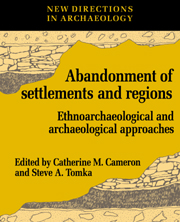Book contents
- Frontmatter
- Contents
- List of figures
- List of tables
- List of contributors
- Acknowledgments
- PART I INTRODUCTION
- PART II REGIONAL ABANDONMENT PROCESSES: ETHNOARCHAEOLOGICAL CASES
- 2 Site abandonment behavior among transhumant agro-pastoralists: the effects of delayed curation on assemblage composition
- 3 Settlement organization and residential variability among the Rarámuri
- 4 Occupational and locational instability in arid land settlement
- 5 Models of abandonment and material culture frequencies
- 6 Agricultural abandonment: a comparative study in historical ecology
- PART III REGIONAL ABANDONMENT PROCESSES: ARCHAEOLOGICAL CASES
- PART IV ABANDONMENT PROCESSES WITHIN SITES: ETHNOARCHAEOLOGICAL CASES
- PART V ABANDONMENT PROCESSES WITHIN SITES: ARCHAEOLOGICAL CASES
- PART VI CONCLUSIONS
- Index
5 - Models of abandonment and material culture frequencies
Published online by Cambridge University Press: 23 May 2010
- Frontmatter
- Contents
- List of figures
- List of tables
- List of contributors
- Acknowledgments
- PART I INTRODUCTION
- PART II REGIONAL ABANDONMENT PROCESSES: ETHNOARCHAEOLOGICAL CASES
- 2 Site abandonment behavior among transhumant agro-pastoralists: the effects of delayed curation on assemblage composition
- 3 Settlement organization and residential variability among the Rarámuri
- 4 Occupational and locational instability in arid land settlement
- 5 Models of abandonment and material culture frequencies
- 6 Agricultural abandonment: a comparative study in historical ecology
- PART III REGIONAL ABANDONMENT PROCESSES: ARCHAEOLOGICAL CASES
- PART IV ABANDONMENT PROCESSES WITHIN SITES: ETHNOARCHAEOLOGICAL CASES
- PART V ABANDONMENT PROCESSES WITHIN SITES: ARCHAEOLOGICAL CASES
- PART VI CONCLUSIONS
- Index
Summary
Introduction
What is the relationship between camp abandonment, mobility (actual and planned), material culture, and the archaeological record? Archaeologists have used artifact frequencies as one indicator of length of occupation and mode of abandonment. However, in order to understand the relationship between mobility, abandonment, and artifact frequencies, it is necessary to examine the factors influencing the accumulation of material culture at camps that have been occupied for various periods of time. The following explores variables traditionally considered important in abandonment studies.
This chapter is based primarily on quantitative data collected in 1987 at a community located just outside the Khutse Game Reserve in the Kalahari Desert of Botswana, although research has been conducted at the community periodically from 1987 to 1992 (Fig. 5.1). The settlement is inhabited by Basarwa (“Bushmen,” San) and Bakgalagadi (Bantu–speakers). It is comprised of a number of scattered camps that are occupied by one to twenty–four people (Fig. 5.2). Camps consist of huts, ash areas where ashes from hearths are dumped, storage platforms, roasting pits, hearths, windbreaks, and informal storage loci such as trees. Some camps also contain goat kraals and pens. Formal middens are not used at Kutse (the alternative spelling for the community to distinguish it from the game reserve). Trash is routinely deposited at ash areas. Since length of camp occupation at Kutse is variable, it is possible to test timedependent hypotheses.
- Type
- Chapter
- Information
- The Abandonment of Settlements and RegionsEthnoarchaeological and Archaeological Approaches, pp. 54 - 73Publisher: Cambridge University PressPrint publication year: 1993
- 5
- Cited by



